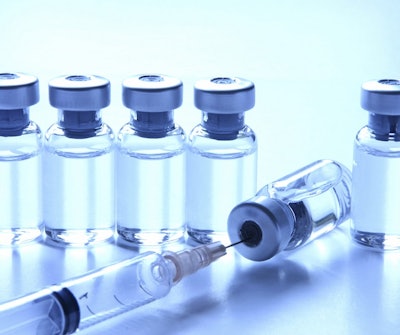
Recombinant vaccines can provide poultry producers with a way to manage several poultry diseases right from the hatchery.
“Recombinant vector vaccines are unique in that you’re covering more than one base with just one specific vaccine,” explained Kalen Cookson, DVM, MAM, director of clinical research, Zoetis.
“The fact that the technology allows us to piggyback other diseases along with the Marek’s vaccine makes it convenient and effective.”
This means that producers can vaccinate against Marek’s disease, Newcastle disease (ND) and infectious bursal disease (IBD) in the hatchery at the same time, which can result in labor savings.
Most recombinant vector vaccines in poultry use herpesvirus of turkeys (HVT) as a backbone. HVT is non-pathogenic, which means that it won’t make the birds sick, have a performance cost or interfere with modified-live vaccines. In addition, the large size of the virus makes it feasible to add the genetic material of another virus or two, like IBDV, NDV or infectious laryngotracheitis virus (ILTV), to the vaccine and adapt to improve control over different viral strains.
“Every five to seven years, we start to see another infectious bronchitis variant,” Cookson said. “That’s just going to up the ante, so we’ll always have to be adjusting to the field situation. Even though we don’t have recombinant vaccines for IBV, per se, the recombinants will be instrumental in helping us manage our respiratory health programs into the future.”
Recombinant vaccines tend to be more expensive than live vaccines to control poultry diseases, but they can be more effective and don’t cause vaccine reactions, so producers must weigh the costs and benefits before deciding on what type of vaccine to use.
Vaccinating in the hatchery, vs on farm
Another benefit of administering recombinant vaccines in ovo at the hatchery is they can improve effectiveness and save on needed labor at the farm.
“It allows us to have 100% coverage, whereas when you’re field vaccinating, you’re lucky to maybe get 80-90% coverage,” he said.
Move away from antibiotics
The move away from antibiotic use in the poultry industry in recent years has also fueled interest in recombinant vaccines.
Antibiotic use in poultry and other livestock has decreased over the past few years due to growing consumer concerns of bacteria acquiring antibiotic resistance.
“This puts more pressure on bird health in general,” Cookson said. “IBD and Newcastle vaccine reactions become an easier target and opportunity for things to become awry when you have a secondary bacterium that can take advantage of any level of respiratory disease or immune suppression.”





.jpg?auto=format%2Ccompress&fit=crop&h=167&q=70&w=250)












